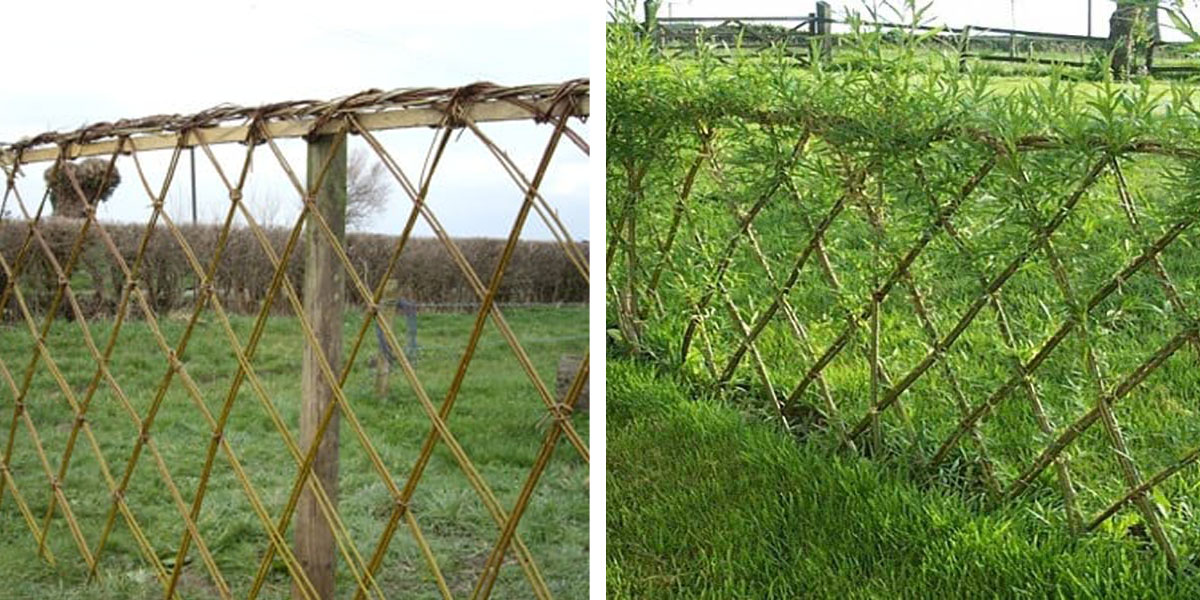How To Build A Living Fence: A Complete Guide

Table of Contents
Planning Your Living Fence
Before you even pick up a shovel, careful planning is crucial for a successful living fence. This section covers the key decisions you'll need to make to ensure your living fence thrives.
Choosing the Right Plants
Selecting the right plants is paramount to the success of your living fence project. Consider these factors:
- Climate: Choose plants that are well-suited to your local climate, including temperature extremes, rainfall, and sunlight exposure. A plant thriving in a Mediterranean climate will likely struggle in a harsh, cold winter.
- Soil Type: Test your soil's pH level and amend it if necessary. Different plants have different soil preferences; some prefer acidic soil, while others thrive in alkaline conditions. Sandy soil requires more frequent watering than clay soil.
- Desired Height and Width: Determine the desired height and width of your living fence. This will help you choose plants that will achieve your vision without becoming overwhelming. Consider the mature size of the plants you select.
Explore various fast-growing hedging plants suitable for living fences:
-
Leyland Cypress: Known for its rapid growth and dense foliage.
-
Arborvitae: Offers a variety of sizes and colors, providing versatility in design.
-
Privet: A classic hedging plant that's easy to maintain and relatively low-maintenance.
-
Hawthorn: Provides a thorny barrier for added security.
-
Bamboo: (Use cautiously, as certain varieties are highly invasive). Offers a fast-growing, dramatic screen, but requires careful selection and management.
-
Research native plants: Native plants are generally better adapted to your local environment and require less maintenance.
-
Consider flowering varieties: Add bursts of color and attract pollinators to your garden.
-
Choose thorned plants for security: If security is a concern, select plants with thorns or prickles.
Design and Layout
Careful design ensures a beautiful and functional living fence.
-
Accurate Measurement: Precisely measure the length of your property line where you plan to install the fence.
-
Detailed Sketch: Create a sketch of your design, considering the mature size of your chosen plants and the spacing between them.
-
Single or Multi-Species: Decide whether you want a living fence consisting of a single species or a mix of different plants for added visual interest and diversity.
-
Future Growth: Account for the plants' mature size to avoid overcrowding.
-
Straight Lines or Curves: Consider incorporating curves for a more natural look, or stick to straight lines for a more formal appearance.
-
Existing Structures and Features: Take into account existing structures, such as buildings or walkways, when planning your fence's layout.
Preparing the Ground
Proper ground preparation is essential for healthy plant growth.
-
Clear the Area: Remove weeds, rocks, debris, and any existing vegetation from the planting area.
-
Soil Testing: Conduct a soil test to determine its pH level and nutrient content. Amend the soil with compost or other organic matter to improve its structure and fertility.
-
Soil Loosening: Till or loosen the soil to a depth appropriate for your chosen plants, ensuring good drainage.
-
Compost Enrichment: Adding compost improves soil fertility and provides essential nutrients for healthy plant growth.
-
Mulch Application: Applying a layer of mulch helps retain moisture, suppress weeds, and regulate soil temperature.
Planting Your Living Fence
With your planning complete, it's time to plant your living fence.
Planting Techniques
Follow these steps for successful planting:
-
Digging Holes or Trenches: Dig individual holes for smaller plants or a continuous trench for larger plants, ensuring adequate spacing.
-
Spacing: Space plants according to their mature size, allowing for sufficient room for growth.
-
Careful Handling: Gently remove plants from their containers, loosening the roots to encourage outward growth.
-
Thorough Watering: Water thoroughly immediately after planting.
-
Plant Supports: Use stakes or other supports to help young plants establish themselves, especially if they are tall and slender.
-
Mulching: Apply a layer of mulch around the base of the plants to retain moisture and suppress weeds.
Choosing the Right Time to Plant
The best time to plant a living fence depends on your climate.
-
Optimal Seasons: Spring or fall are generally ideal, allowing plants to establish themselves before the stress of summer heat or harsh winter conditions.
-
Avoid Extremes: Avoid planting during extreme heat or cold, as this can damage young plants.
-
Local Weather: Consider your region's specific weather patterns, including frost dates and potential rainfall.
-
Local Guidelines: Check with local gardening resources for the best planting times in your area.
-
Species-Specific Needs: Research the specific planting requirements of your chosen plant species.
Maintaining Your Living Fence
Ongoing maintenance is key to a healthy and beautiful living fence.
Watering and Fertilizing
Regular watering and fertilization are crucial, especially in the first year.
-
Regular Watering: Water regularly, especially during dry periods, ensuring the soil remains consistently moist but not waterlogged.
-
Annual Fertilization: Fertilize annually using a slow-release fertilizer appropriate for the chosen plants.
-
Appropriate Fertilizer: Choose a fertilizer formulated for the specific needs of your plant species.
-
Deep Watering: Deep, infrequent watering encourages deep root growth.
-
Rainfall Adjustments: Adjust watering frequency based on rainfall.
Pruning and Shaping
Regular pruning is essential for maintaining the desired shape and size of your living fence.
-
Regular Pruning: Prune regularly to maintain the desired shape and size, removing dead, damaged, or crossing branches.
-
Disease Removal: Remove any dead or diseased branches to prevent the spread of disease.
-
Proper Techniques: Learn basic pruning techniques to avoid damaging the plants.
-
Sharp Shears: Use sharp, clean pruning shears to make clean cuts.
-
Professional Help: Consider seeking professional help for more complex pruning tasks.
Pest and Disease Control
Monitor your living fence for pests and diseases.
-
Regular Inspection: Regularly inspect your living fence for signs of pests or diseases.
-
Prompt Treatment: Address any infestations or diseases promptly using appropriate methods.
-
Organic Options: Whenever possible, use organic pest and disease control options.
-
Accurate Identification: Accurately identify pests or diseases before treating them.
-
Expert Advice: Consult with local gardening experts or your local agricultural extension office for advice on managing pest and disease problems.
Conclusion
Building a living fence is a rewarding project that offers numerous benefits, from increased privacy and property value to environmental sustainability and aesthetic appeal. By following these steps and choosing the right plants, you can create a beautiful and thriving living fence that will enhance your property for years to come. Start planning your own living fence today and enjoy the natural beauty and environmental benefits! Remember to research local plant options for the best results with your living fence design. Don't hesitate to seek advice from local gardening experts to ensure the success of your living fence project.

Featured Posts
-
 Downtown Seattle Shooting Three Suffer Injuries
May 29, 2025
Downtown Seattle Shooting Three Suffer Injuries
May 29, 2025 -
 Drama Nft Nike Pembeli Menuntut Rp 84 Miliar
May 29, 2025
Drama Nft Nike Pembeli Menuntut Rp 84 Miliar
May 29, 2025 -
 Air Jordan May 2025 New Sneakers And Release Info
May 29, 2025
Air Jordan May 2025 New Sneakers And Release Info
May 29, 2025 -
 2 Hour Thriller Mind Blowing Climax 1 On Ott
May 29, 2025
2 Hour Thriller Mind Blowing Climax 1 On Ott
May 29, 2025 -
 Stranger Things The First Shadow First Look Photos Revealed
May 29, 2025
Stranger Things The First Shadow First Look Photos Revealed
May 29, 2025
Latest Posts
-
 Maryland Drivers Registering Cars In Virginia Costly Consequences For The State
May 30, 2025
Maryland Drivers Registering Cars In Virginia Costly Consequences For The State
May 30, 2025 -
 Analysis 311 Heatwave Fatalities In England Underscore Public Health Concerns
May 30, 2025
Analysis 311 Heatwave Fatalities In England Underscore Public Health Concerns
May 30, 2025 -
 Hot Weather Claims 311 Lives In England Understanding The Risks And Prevention Strategies
May 30, 2025
Hot Weather Claims 311 Lives In England Understanding The Risks And Prevention Strategies
May 30, 2025 -
 311 Heat Related Deaths In England A Wake Up Call For Heatwave Preparedness
May 30, 2025
311 Heat Related Deaths In England A Wake Up Call For Heatwave Preparedness
May 30, 2025 -
 Urgent Travel Advice Foreign Office Warning For Brits Visiting Greece
May 30, 2025
Urgent Travel Advice Foreign Office Warning For Brits Visiting Greece
May 30, 2025
